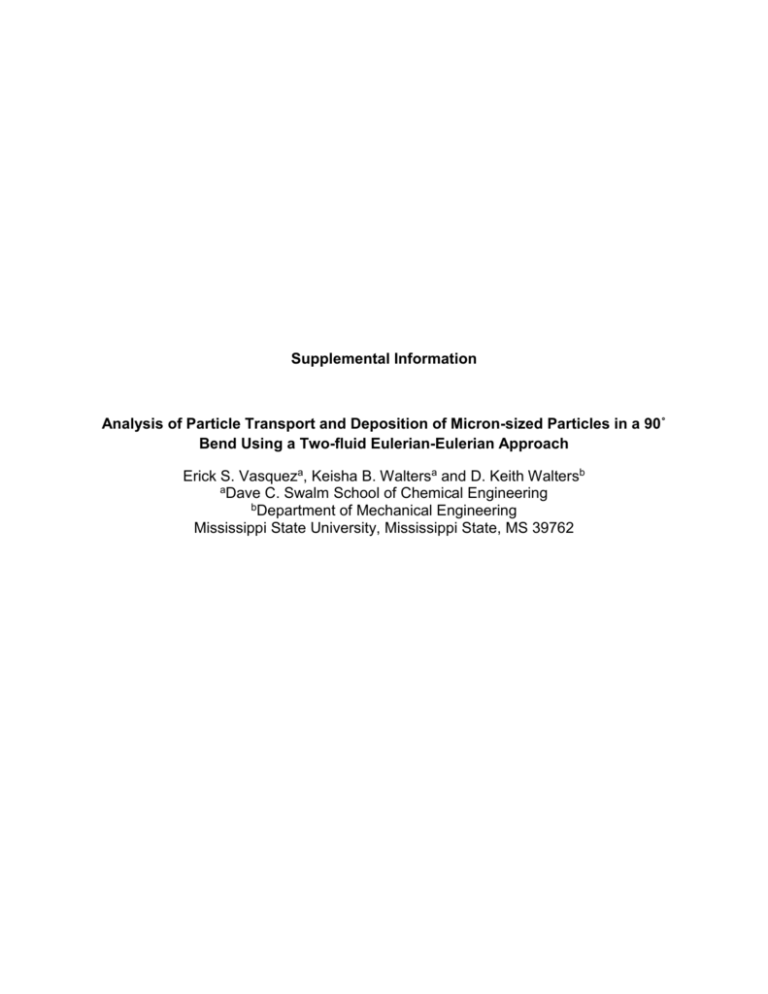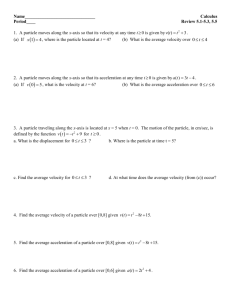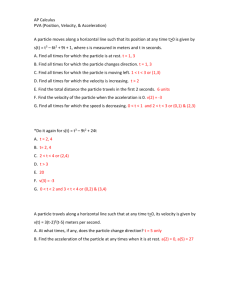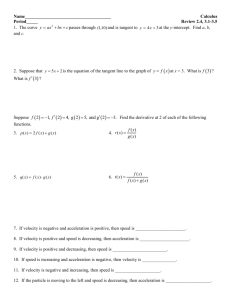Supplemental Information Analysis of Particle Transport and
advertisement

Supplemental Information Analysis of Particle Transport and Deposition of Micron-sized Particles in a 90˚ Bend Using a Two-fluid Eulerian-Eulerian Approach Erick S. Vasqueza, Keisha B. Waltersa and D. Keith Waltersb aDave C. Swalm School of Chemical Engineering bDepartment of Mechanical Engineering Mississippi State University, Mississippi State, MS 39762 S1. Comparison of Boundary Conditions on the Eulerian-Eulerian Model The Lagrangian based model with near-wall velocity corrections of Longest and Oldham (2008) was also implemented in the developed Eulerian-Eulerian model. However, no significant changes in cumulative particle deposition percentage were observed in comparison to the Eulerian-Eulerian model developed in this study. In Table S1 total particle deposition results are shown for three particle diameters. Using the lowest level of mesh refinement for case I (Re = 1000), no significant change in the particle deposition percentage was observed from applying the near-wall correction boundary condition (Longest and Oldham, 2008). We attribute this result to the highly refined near-wall mesh, which confirms that the Eulerian-Eulerian model established in this work does not require a special boundary condition to accurately predict total particle deposition. A full comparison of these data with previous models and the experimental data is provided in Section 3.2.1. Table S1. Boundary condition (BC) effects for total deposition percentage using the Eulerian-Eulerian method with a near-wall velocity correction approximation (BC on) and the Eulerian-Eulerian method (BC off) Case I: Re 1000 non-refined mesh Deposition Particle % St diameter BC BC (micron) on off 0.28 7.3 32.66 33.16 0.37 8.39 67.81 68.91 0.9 13.09 94.64 95.59 Table S2. Particle sizes (and corresponding Stokes number) examined on refined and coarse grids at different Re numbers Re = 100 Particle diameter (m) Stokes # 5.39E-06 5.91E-06 6.87E-06 7.65E-06 8.83E-06 9.23E-06 9.77E-06 0.28 0.34 0.46 0.57 0.76 0.83 0.93 1.15E-05 1.22E-05 1.29 1.46 Re= 1000 Particle diameter (m) 5.69E-06 7.30E-06 7.92E-06 8.39E-06 9.15E-06 1.04E-05 1.15E-05 1.31E-05 1.46E-05 1.54E-05 Stokes # 0.17 0.28 0.33 0.37 0.44 0.57 0.70 0.90 1.12 1.24 S2. Airflow velocity profiles Airflow velocity profiles are shown in Figure S1 for Reynolds number (Re) of 100 and 1000 along two different symmetry axes (z=0; x=0) and three elbow locations (0°; 45°; 90°). At both Re numbers, higher velocity magnitudes were observed towards the outer elbow walls due to inertial fluid forces along the symmetry axis (z = 0) (Figures S1A and B). Conversely, on the perpendicular axis (x = 0), velocity profiles were symmetric for both cases (Re = 100 and Re = 1000) as shown in Figures S1C and S1D, respectively. These results agree with numerical calculations by Tsai and Pui (1990) and simulation results of Pilou et al. (2011) for an elbow geometry under the same flow conditions (Re = 100, De = 38; Re = 1000, De = 419). Using these confirmed airflow velocity profiles, Eulerian simulations were performed for the particle phase, as discussed in Section 3.2. Figure S1. Axial velocity profiles at z = 0 (symmetry plane) for (A) Re = 100 and (B) Re = 1000 at three different elbow locations (left to right): 0° (inlet), 45°, and 90° (outlet). Velocity profiles are shown for the perpendicular symmetry plane (x = 0) for (C) Re = 100 and (D) Re = 1000 at the same elbow locations (0°; 45°; 90°). S3. Secondary Airflow Streamlines Secondary flow streamlines of the air flow velocity profiles were also examined (Figure S2). Formation of counter-rotating vortices was observed for both the Re = 100 and Re = 1000 cases, as seen in the 45° (elbow curvature) and 90° (geometry exit) cross-sections (Figure S2). Specifically, two counter-rotating vortices were observed at each condition. For the highest Re case (Re = 1000), this pair of vortices is closer to the inner wall of the bend. Conversely, at Re 1000 the maximum axial velocities move towards the outer wall of the bend (outer wall is opposite the inner wall, as depicted in Fig. S2). These results are in agreement with previous studies showing increased centrifugal forces and the resultant effect on vortices position at higher Re and De number airflow in a 90° bend (Breuer et al., 2006; Pilou et al., 2011). Figure S2. Secondary airflow velocity streamlines and axial velocity profiles at 45° (top) and 90° (bottom) for Re = 100 (left) and Re = 1000 (right) showing the formation of counter-rotating vortices and the effect of higher centrifugal forces on the vortex positions and maximum velocity positions. S4. Complementary Equations Reynolds, Dean, and Stokes numbers were calculated for a parabolic inlet velocity profile using the fluid and particle properties listed in Table S3. Equations for these dimensionless numbers are as follows: 𝑅𝑒 = 𝐷𝑒 = 𝑆𝑡 = 𝜌𝐷𝑈𝑚𝑎𝑥 (S1) 2µ 𝑅𝑒 (S2) √𝑅𝑜 2𝑈 𝜌𝑝 𝑑𝑝 𝑚𝑎𝑥 (S3) 18µ𝐷 The radius of curvature of the bend (R) was calculated based on the dimensionless curvature radius (Ro) as described by Pui et al. (1987) and shown in Equation S4. 𝑅𝑜 = 2𝑅 (S4) 𝐷 Table S3. Fluid properties and case descriptions Fluid and Particle Properties Temperature 273 K fluid-phase density, ρ 1.18 kg/m3 fluid dynamic viscosity, µ 1.85E-5 kg/(m s) Particle density, ρp 895 kg/m3 Case I Re = 1000 (De = 419) Tube diameter, D Maximum fluid velocity, Umax Ro, curvature radius R, radius of curvature of the bend Case II Re = 100 (De = 38) Tube diameter, D Maximum fluid velocity, Umax Ro, curvature radius R, radius of curvature of the bend 0.00395 m 7.72 m/s 5.7 0.01126 m 0.00093 m 3.371 m/s 7 0.00326 m References Breuer, M., Baytekin, H. T., Matida, E. A. (2006). Prediction of aerosol deposition in 90˚ bends using LES and an efficient Lagrangian tracking method. Journal of Aerosol Science 37:1407-1428. Longest, P. W. and Oldham, M. J. (2008). Numerical and experimental deposition of fine respiratory aerosols: Development of a two-phase drift flux model with nearwall velocity corrections. Journal of Aerosol Science 39:48-70. Pilou, M., Tsangaris, S., Neofytou, P., Housiadas, C., Drossinos, Y. (2011). Inertial particle deposition in a 90 laminar flow bend: An Eulerian fluid particle approach. Aerosol Science and Technology 45:1376-1387. Pui, D. Y. H., Romay-Novas, F., Liu, B. Y. H. (1987). Experimental study of particle deposition in bends of circular cross section. Aerosol Science and Technology 7:301-315. Tsai, C.-J. and Pui, D. Y. H. (1990). Numerical Study of Particle Deposition in Bends of a Circular Cross-Section-Laminar Flow Regime. Aerosol Science and Technology 12:813-831.







